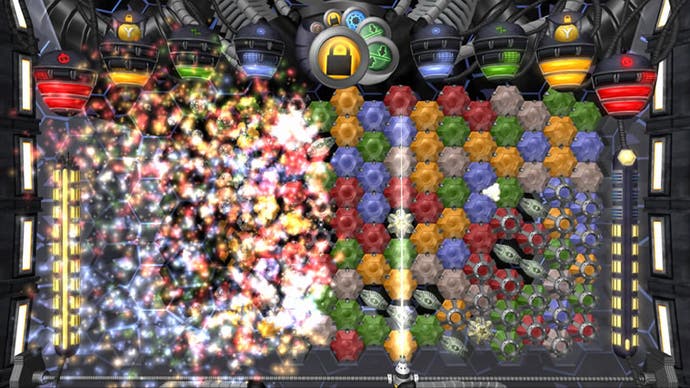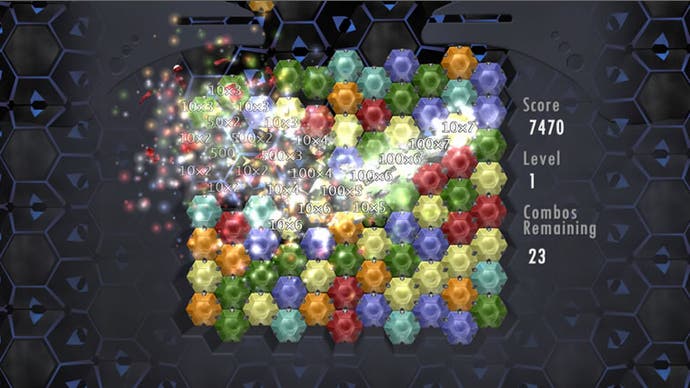Hexic 2
Turn it on again.
As you know, the original Hexic was bundled with all premium Xbox 360 hard disks back when the console launched in November 2005. This was a great way for Microsoft to introduce people to its frequently wonderful Xbox Live Arcade, and the back-to-basics pick-up-and-play ethos behind it. Sure, the game wasn't new - it had been available on PC for some time - but for many of us, this was the first time we'd encountered Alexey 'Tetris' Pajitnov's new puzzler.
The game's deceptively simple concept was to clear coloured hexagon tiles from the play area. You did this by rotating a cluster of three hexagon-shaped pieces until the one selected lined-up with two or more of the same colour. When they matched up, the pieces above them fall into the space created, often setting off a chain reaction. And so it went on: you levelled up after you've matched a specific number of tiles, and then had to cope with a greater variety of colours thrown into the fray - making matching tiles progressively more difficult. Occasionally, bomb tiles would appear, and unless you defused them within a set number of 'moves' it'd be game over. Damn bombs.
Out of the sinking
Just like Pajitnov's previous addictive efforts, Hexic can be a real time-sink thanks to its effortlessly intuitive design, and clear, uncomplicated play mechanics. But underneath lay a deceptively complex game which had a real slow burn feel to it, and numerous tricks up its sleeve once you got to know it. For example, if you ever mastered how to create Starflowers (a ring of six same-coloured tiles) or - the ultimate - Black Pearls (a ring of six Starflowers), the chances are you probably ended up playing it more than practically any other game on the machine to date. And if you're that good at it, you deserve a whole box of Jaffa Cakes.
But if you're going to give a game like Hexic away for free, you put the user base in a bit of a dilemma when you it comes to releasing a sequel. With only a few tweaks to the core concept, it's perhaps pushing it to expect anyone but the addict die-hards to be pumped at the thought of shelling out 800 points for a game which, to be blunt, doesn't add all that much to what was on offer the first time around. For once, we can't trawl out the standard fall-back of "if you missed out on the original, then this one's even better" line - because the simple fact is you've all got Hexic already. And if you weren't really into it the first time around, this sequel probably won't change your mind.
That said, those that did succumb to its charms will appreciate the refinements to this compulsive twisty-turny puzzler. At first glance, you might think not much has changed at all. The premise is almost exactly the same, with the same basic modes making a return, which means Marathon, Timed and Survival all appear again.
Flowered Up

But playing around with it reveals a few new tweaks which make the game a little more fun to play. For example, Carbonated Games now lets you create what's known as the Emerald by lining up five hexagons in a row. Once created, the Emerald piece allows you to flip the two tiles either side of it, making for a subtly different type of game. And if you're really good, you can also create the Ruby if you manage to line-up five Starflower pieces in a row. Armed with this, you get to flip the four tiles either side, so the potential for rejigging the play area strategically is enormous once you really master the fundamentals. In addition - for the really advanced players, you can use the Black Pearls to rotate the three tiles around them, but, frankly, we were never good enough at the game to find that out [/sad face]. Perhaps the key addition is that you can also now explode any of these pieces by holding down B, which is a great last-ditch tactic when everything's going wrong and you need to create a chain reaction or shake up the play field for whatever reason.
But aside from these tweaks that make the game a lot more accessible, the most significant new addition is the Battle Mode - a two player one-on-one fight which you can play against the computer, or against a human opponent offline or online over Xbox Live. In this mode, the ultimate idea is to topple you opponent by getting rid of your tiles quicker than they can - but that's perhaps oversimplifying it. The screen is divided vertically into two, and at the top you both have four 'vessels' which fill with colour as and when you clear the tiles off the screen.

Over time, you'll accumulate enough in your vessel to pull off one of numerous special 'attacks' with the Y button - such as Push (reduce the size of your foe's play field), Lock (freeze a set number of their tiles), Clear (gets rid of some of your tiles), or Bomb (places a bomb somewhere on your opponent's playfield). If you think of Hexic as quite a serene way to pass the time, then Battle mode puts the stress back into the game, and then some. Knowing when to unleash these attacks suddenly adds a great deal of strategy to the game: use them too soon and the impact might be lost, but wait too long and your opponent might strike a fatal blow. Played against the computer it's a lot of fun, but comes into its own online - though at the expense of a curious amount of lag if you happen to get lumbered with the wrong opponent the other side of the world.
More fizz
Visually you shouldn't expect miracles, but Carbonated Games has buffed up the artwork a little, giving it an appealing acid fried set of effects that fans of LSD might appreciate/ freak out to. Likewise, the audio's trancy vibe has continued for the sequel, and adds to that zen-like feeling you get when you play it for hours on end as we found ourselves doing.
But Battle mode or not, the question of whether Hexic 2 is for you is a pretty straightforward one to answer. If you liked the original, and poured endless hours into it, then you should definitely get this one: there are just about enough tweaks and changes to make it feel different enough to justify a purchase - especially the chance to play a mate online. If the last one left you cold, then only consider it if competitive multiplayer is your thing. It's still a great little puzzle game, and one that definitely warrants a trial download....but diminishing returns have definitely kicked in with this unapologetically lightweight sequel.

